Election results 2017: The most diverse Parliament yet
- Published
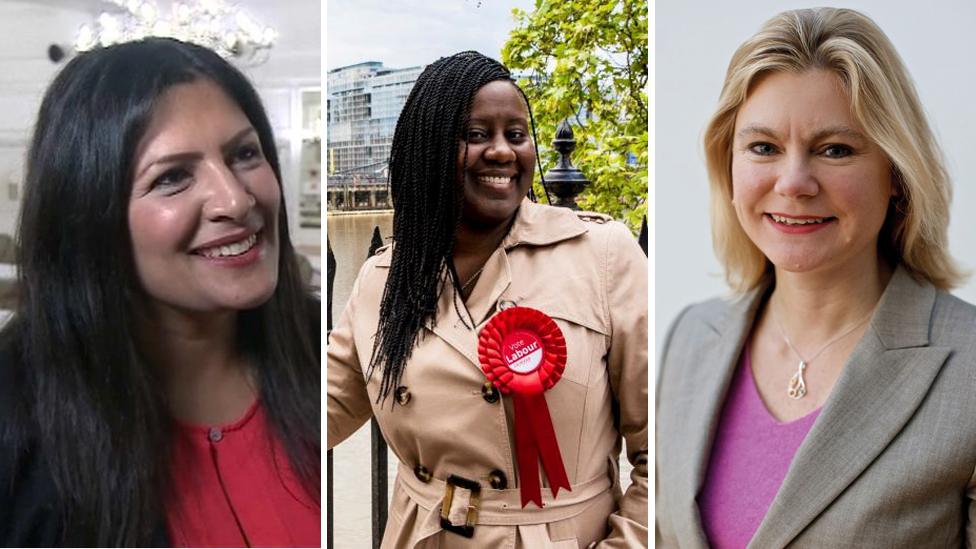
MPs Preet Gill, Marsha De Cordova and Justine Greening reflect the diversity of Parliament
Asked to describe an average MP, many will imagine a privately-educated, straight, white man. But the make-up of the Commons is changing, with record-breaking strides being made in the 2017 general election.
The vote delivered the most diverse House of Commons ever with a rise in the number of women, LGBT and ethnic minority MPs elected.
There has also been an increase in MPs who went to state school as well as a boost for disabled representation.
Here is how it breaks down:

Lesbian, Gay, Bisexual and Transgender
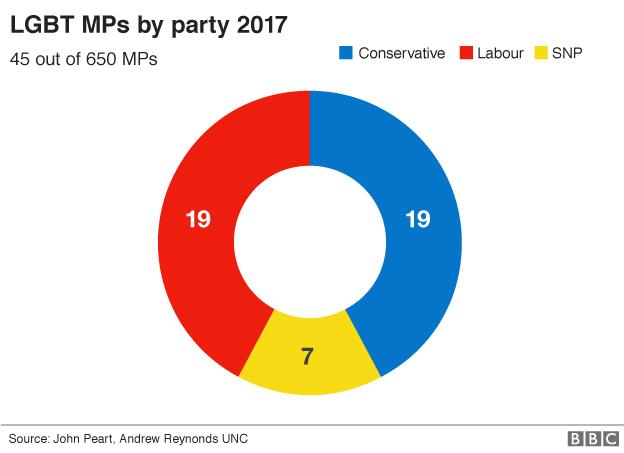
There are 45 MPs who openly define themselves as lesbian, gay, bisexual or transgender (LGBT), according to senior government equality advisor, external John Peart.
That is a 40% increase from the 2015 election - when there were 32, external - and includes 19 from Labour, 19 from the Tories and 7 from the SNP.
Prominent LGBT MPs include Scottish Secretary David Mundell, Education Secretary Justine Greening, and shadow defence secretary Nia Griffith.
Ms Griffith publicly revealed her sexuality when she posed for a photo of 28 LGBT MPs and peers for the Independent on Sunday, external in 2016.
Writing in Pink News, external, she said: "Visibility matters, and it makes it easier for young people in particular to know that they can go just as far whether they are gay or straight."
Stonewall, an LGBT rights charity, says the rise in the number of LGBT candidates "demonstrates how much progress Britain has made".
Bex Stinson, head of trans inclusion at the charity, added: "Having LGBT people visible in public life also helps foster an inclusive society, and provides strong role models for those who don't yet feel able to be themselves and for young LGBT people."
However, she said more needs to be done to increase transgender representation after none of the nine transgender candidates who stood were elected.

Ethnic minorities
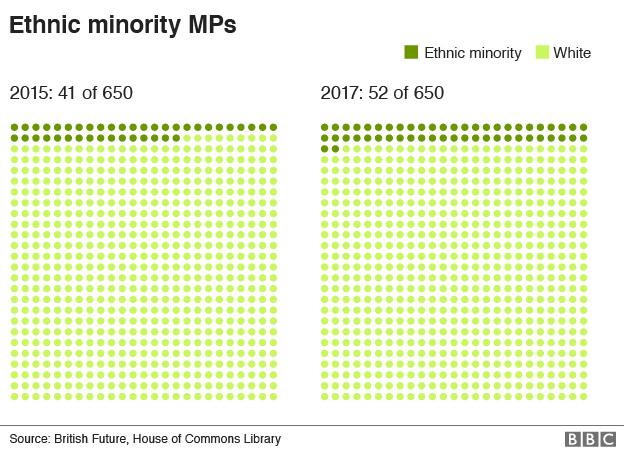
The general election of 1987 saw the first ever black MPs voted into the House of Commons.
Fast forward 30 years and the 2017 result has seen 52 ethnic minority MPs elected, says think tank British Future, external.
Of those, 32 are Labour, 19 Conservatives and one Lib Dem.
It is an increase from 41 in 2015 and the highest number ever.
They include Preet Gill, the first female Sikh MP, shadow home secretary Diane Abbott, who became the first ever black female MP in 1987, and Manchester's first Muslim MP Afzal Khan.
Operation Black Vote said many more ethnic minority candidates won in non-urban areas which showed the UK was "comfortable with its multicultural society."
Director Simon Woolley said: "More talented BME faces will help transform Parliament and inspire many more to believe that we all have a voice and a place in our society."
Steve Ballinger, director of communications for British Future, said: "It's got to be good for politics that gradually Parliament is getting closer to looking a bit more like the electorate that it serves."
He said the majority of the MPs from ethnic minorities would be sitting on Labour benches, which was partly due to the Tories not choosing enough ethnic minority candidates.
"I know there are calls within the Conservative Party to do better in that respect."

Women
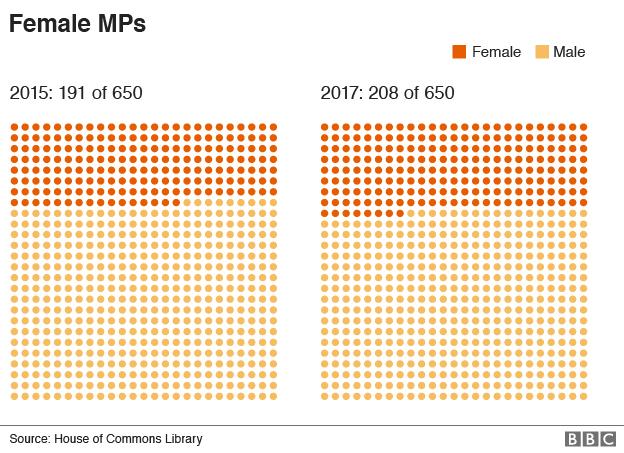
There is more gender equality than ever before in Parliament after a record 208 women were elected in Thursday's vote.
Nearly 100 years after the law was changed to allow women to become MPs, they now make up 32% of the Commons.
The number of women MPs has increased by almost 9% since the 2015 election, when 191 were voted into Parliament.
Labour has the most women with 119, while the Tories have 67, the SNP 12 and the Lib Dems 4.
But with females making up more than 50% of the UK population, the Commons still has a way to go to truly represent the make-up of the country.
The Fawcett Society, which campaigns for women's rights, says progress has stalled.
Chief executive Sam Smethers said: "The time has come for a legally enforceable target to achieve the radical and sustainable change we need."

Disability
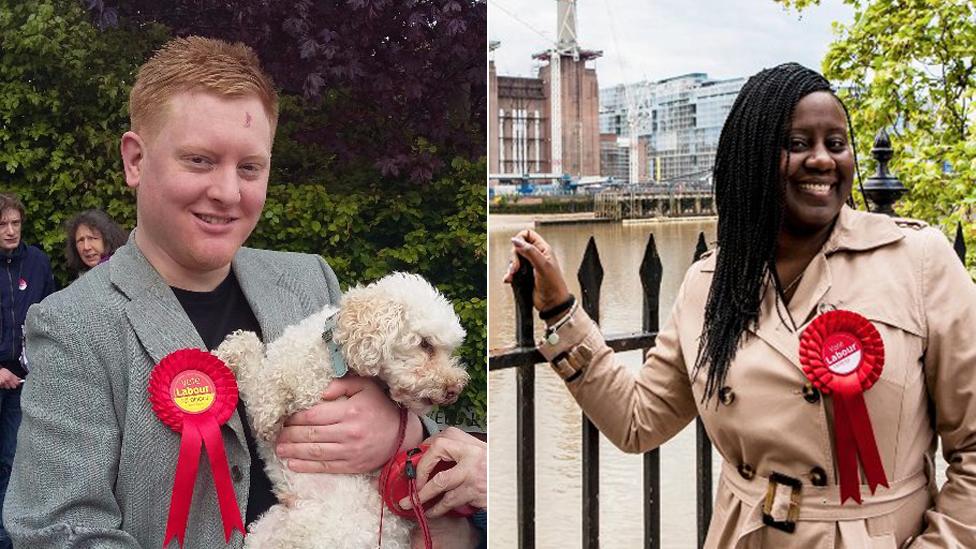
While there are no definitive figures on the number of disabled MPs, it appears there has been an increase in the 2017 Parliament.
Labour has two new MPs in the Commons who have disabilities.
Marsha de Cordova, who represents Battersea, is registered blind and used her victory speech, external to champion disabled rights.
Jared O'Mara, who has cerebral palsy hemiparesis, took Sheffield Hallam from former Deputy Prime Minister Nick Clegg.
He has previously written, external about the importance of political parties having a strong representation of disabled candidates.
Lib Dem MP Stephen Lloyd, who is hard of hearing, external, returns to Parliament after losing his seat in the 2015 election.
Conservative MP Robert Halfon, who was born with mild cerebral palsy and has since developed osteoarthritis, was re-elected.
He is joined in Parliament by fellow Tory Paul Maynard, who also has cerebral palsy.
Scope's chief executive Mark Atkinson said it was encouraging to see an increase in the number of disabled politicians elected.
"Whilst there is more work to do, this is a positive step forward in combating the under-representation of disabled people in public life."

Education
David Cameron, Boris Johnson and George Osborne are just a few of the notable past and present MPs to have received a private education.
But 2017 has seen a shift in educational background, with more than half of those elected having been to state schools.
Analysis by the Sutton Trust, external found that 51% of MPs in the new Commons went to comprehensive schools, while 29% went to private school and 18% selective states.

In 2015, the figures were 49%, 32% and 19% respectively.
The analysis found 45% of all Conservative MPs elected in 2017 were privately educated, compared to 14% of Labour MPs and 6% of SNP MPs.
The figures do not include MPs who were home schooled or educated abroad.
Sutton Trust chairman and founder Sir Peter Lampl said the "landscape of British politics has changed considerably".
But he said the number of MPs attending private school was still far higher than the general population which stands at 7%.
He added: "If parliament is to truly represent the nation as a whole, able people from all backgrounds should have the opportunity to become MPs."